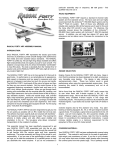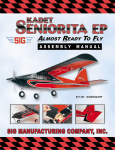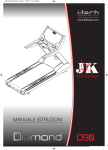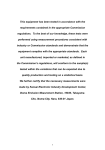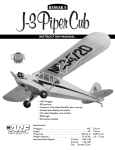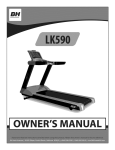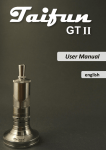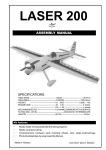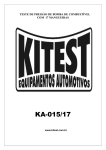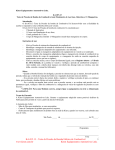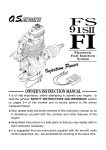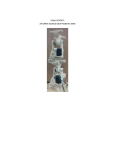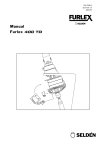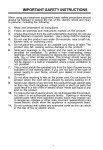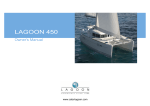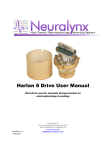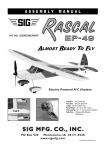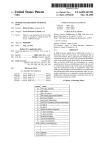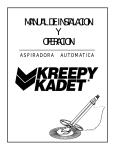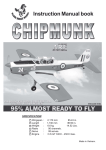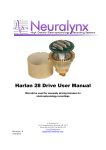Download Introduction
Transcript
Introduction The original KADET SENIOR was designed in the mid-80's by Claude McCullough and shortly thereafter, it became a SIG kit. Claude put a great deal of thought into the KADET SENIOR design and came up with an R/C training aircraft that was just about perfect. As proof, it's safe to say that in the intervening years, the KADET SENIOR has been used to teach thousands of modelers to fly. In addition, the design has been used for many other applications as well as being "kit bashed" into any number of different configurations. The KADET SENIOR kit is still in production and remains a true model aviation classic! Over the years, we've received a lot of questions about the KADET SENIOR. But of all the questions received here at SIG regarding the KADET SENIOR, the number one issue has been how to add ailerons to the wing. Even though the design was never intended for aerobatics, many modelers feel that with the addition of ailerons, the KADET SENIOR would become the "ultimate trainer". We have listened carefully to all these suggestions and comments and as a result, we are pleased to present the new KADET SENIOR ARF. The ARF version of this great design retains all of the really good flying characteristics of the original SENIOR, but now features true "barn door" ailerons. To make the ailerons more effective, the dihedral angle has been reduced from the original design. To make the airplane IMAA legal, the wingspan has been increased to 80-1/4". The increased span also increased the wing area to a huge 1180 sq. inches! This means that the KADET SENIOR ARF is capable of carrying a lot of additional equipment, such as a lighting system for night flying, cameras, etc., and still retain a very favorable wing loading. The radio compartment in the fuselage is roomy enough for almost anything that you might want to carry aloft. All of this capability still only requires a typical .40 or .46 2-stroke engines or a .40 - .65 4-stroke engines to fly the airplane. The KADET SENIOR ARF kit has been expertly covered with AeroKote™, featuring either transparent blue or transparent red to show off the beautiful structure. The wing has been designed to be a 2-piece assembly, allowing easy transportation to and from the field and simplified storage. The beautiful fiberglass cowl allows you to customize the required openings for your particular engine and muffler set-up. The landing gear system is very forgiving, making even the worst landings look just a bit better. We urge you to read this assembly manual completely before assembly. Familiarize yourself with the parts and their assembly sequences. The successful assembly and flying of this airplane is your responsibility. If you deviate from these instructions, you may wind-up with problems later on. The KADET SENIOR ARF is certainly a suitable R/C model for beginning modelers. However, it is important to understand that if this is your first R/C model, you will need to find and use a qualified R/C flight instructor to test fly the airplane and teach you how to fly it. If this is your first radio control model airplane, DO NOT attempt to fly it without a qualified instructor. . Radio Equipment The KADET SENIOR ARF requires a standard 4-channel radio system and five standard servos. We have used and can highly recommend both the Airtronics™, RD6000 Sport system and the Hitec™ Flash 4X system. Both of these affordable and reliable radio systems offer all the features you'll need for this and the many other R/C aircraft in your future. For reference, this assembly manual shows the installation of the Airtronics™ RD-6000 Sport radio system with Airtronics™ #94102 standard servos. In addition, you'll need two 24" aileron servo lead extensions and an aileron servo Y-harness for connection to the receiver. Engine Selection Engine choices for the KADET SENIOR ARF are many. Choosing the right engine is important and should be based on your intended end-use for the airplane. For example, if your KADET is going to be used as a trainer, then, either a .40 - .46 2stroke engine or a .40 - .65 4-stroke engine would be about ideal. Actually, any of these engines will fly the KADET quite nicely and well within its intended flight envelope. 2-stroke engines need not be bearing equipped but from experience, engines with bearings tend to be a better long-term choice. We have found that the Irvine .40, .46, and .53 2-stroke engines are ideal for the KADET SENIOR ARF. These engines are extremely reliable, very user-friendly, and quiet. Whatever engine you choose, take the time to carefully break it in according to the manufacturer's instructions. A good running, reliable engine is a minimum requirement for the enjoyment of this or any R/C model aircraft. Covering Material Your KADET SENIOR ARF has been professionally covered using AeroKote™. This material is well known for its ease of application, light weight and consistency of color. If you live in a dry climate, you may notice that some wrinkles may develop after removing the covered parts from their plastic bags. This is perfectly normal in low humidity climates. Your KADET SENIOR ARF is covered with SIG AeroKote™ #SIGSTL100 White and #SIGSTL010 Transparent Red or #SIGSTL050 Transparent Blue Your model was built and covered in a part of the world, which has relatively high humidity and therefore, the wood was likely carrying a fair amount of moisture. When exposed to drier air, the wood typically loses this moisture, dimensionally "shrinking" in the process. In turn, this may cause some wrinkles. However, wrinkles are easy to remove by just using a hobby type heat iron. We suggest covering the iron's shoe with a thin cotton cloth, such as an old T-shirt, to prevent scratching the film. The iron should be set to about 220oF - 250oF (104o C - 121oC). Use the heated iron to lightly shrink the material - do not press on it. Then, lightly iron the material back down to the wood. You can also use a hobby-type heat gun to re-shrink the covering but you must be careful around seams or color joints. Re-heating seams may cause them to "creep", making them unsightly. This is especially true with the KADET SENIOR ARF and its 2-color trim scheme. You must also be careful when using a heat iron or heat gun when working around the windshield and side windows - heat will distort this clear plastic material. Required Tools For proper assembly, we suggest you have the following tools and materials available: A selection of glues - SIG Thin CA, SIG Thick CA, SIG KwikSet 5-Minute Epoxy and SIG Kwik-Shot CA Debonder Screwdriver Assortment Pliers-Needle Nose & Flat Nose Diagonal Wire Cutters Small Allen Wrench Assortment Pin Vise for Small Dia. Drill Bits Hobby Knife with Sharp #11 Blades Small Power Drill With Selection of Bits Dremel® Tool With Selection of Sanding & Grinding Bits Scissors Sandpaper Heat Iron & Trim Seal Tool Masking Tape Paper Towels Alcohol and/or Acetone For Epoxy Clean-up . Complete Kit Parts List The following is a complete list of all parts contained in this kit. Before beginning assembly, we suggest that you take the time to inventory the parts in your kit. Note that the hinges for the rudder, elevators, and ailerons are in place but not yet glued. Please also note that the bolts and nuts required to mount your engine to the motor mounts are not included and must be purchased separately. Basic Aircraft Parts 1 Fuselage 1 Wing Panel Set With Ailerons in Place with Unglued CA Hinges 1 Horizontal Stabilizer & Elevator 1 Vertical Fin & Rudder Set with CA Set With CA Hinges Hinges 2 3-3/4” Dia. Main Wheels 1 3-1/4” Dia. Nose Wheel 2 Main Landing Gear Wires 4.5 Plated Wire 4 #3x16mm PWA Screws 2 4.5mm i.d. Plastic Wheel Spacers 2 4.5mm i.d. Wheel Collars With Set Screws 1 Formed Nose Gear Wire 4mm Plated Wire 1 Nylon Nose Gear Steering Bracket 1 Nylon Nose Gear Steering Arm 4 M3x30mm Bolts with 4mm Brass Insert & M3x6mm Setscrew 4 M3 Flat Washers 4 M3 Lock Washers 1 4mm i.d. Plastic Wheel Spacer 2 4mm i.d. Wheel Collars With Set Screws 1 Fuel Tank Body 320cc (10.8 oz.) 1 Rubber Stopper 1 Metal Clamp - Front 1 Metal Clamp - Rear 1 M3x18mm Bolt 1 Metal Clunk Fuel Pick-Up 1 Length of Fuel Tubing for inside of tank 1 Aluminum Tube 3mm o.d.x60mm 1 Aluminum Tube 3mm o.d.x50mm 1 Aluminum Tube 3mm o.d.x40mm 4 M3 Lock Washers 4 M3 Flat Washers 1 Fiberglass Cowl With Four #3x8mm PWA Mounting Screws Sub-Assemblies Main Landing Gear Assembly 2 Nylon Landing Gear Retaining Straps Nose Gear Assembly Fuel Tank Assembly Motor Mount Assembly 2 Filled Nylon Motor Mounts (1) Right, (1) Left 4 M3x20mm Mounting Bolts SIG 2” Diameter Spinner Assembly White With Inserts and Mounting Screws - P/N SIGSP201 Hardware Mounting Package 2 Servo Hatch Cover/Mounts White Plastic - (1) Right, (1) Left 8 #2x8mm (5/16”) PWA Screws 4 #2x6mm (1/4”) PWA Screws - 4 Hardwood Servo Mounting Blocks - Servo Hatch Screws Aileron Servo Block Screws 5/16”x1/2”x13/16” 1 Balsa Fuel Tank Retainer 8.2mmx20mmx116mm 2 1/4-20x1-1/2” SIG Nylon Wing 4 Nylon Control Horns Bolts (2) Ailerons, (1) Elevator, (1) Rudder 4 M2x20mm Bolts - Rudder & Elevator Control Horn Mounting 4 #3x16mm PWA Screws Aileron Control Horn Mounting 2 Nylon Control Horn Bases (1) Elevator, (1) Rudder Miscellaneous 1 Hardened Aluminum Blade Main Wing Joiner 1/8"x11/16"x12-1/16” 1 Rear Wing Locating Pin, Steel - 2 Balsa Dowel Pushrods 1/8" dia.x2-3/8" 10mm dia.x85cm (33-1/2") 2 Inner Nylon Pushrod Tubes - 1/8" o.d.x16-15/16" (Throttle & Nose Wheel Steering) 4 Heat Shrink Tubing 17mmx50mm (Wire Pushrod Retainers) 7 Threaded R/C Links (2) Ailerons, (1) Rudder, (1) Elevator, (2) Throttle, (1) Nose Wheel Pushrod 2 Rudder & Elevator Pushrods 2mm dia.x102mm with "Zbend" 2 Rudder & Elevator Pushrods, Threaded one end 2mm dia.x30cm 2 Aileron Pushrods, Threaded one end with "Z-bend" 2mmx80mm 3 Fully Threaded Studs 2mmx20mm (Nose Wheel pushrod at servo, Throttle pushrod, both ends) 1 Nose Wheel Pushrod, Threaded one end with "Zbend" 2mmx40mm 1 Molded Clear Plastic Side Window Set (1) Right, (1) Left 1 Decal Set, 5"x18", 1-color (white) 1 Assembly Manual - P/N SIGDKM258ARF . WINGS The wings have been designed and made to be a 2-piece system, joined by the main aluminum blade joiner at the spar box location and a steel locating pin at the rear. This joiner system has proven to be very tough and easy to use. An obvious benefit, especially with a model of this size, is the fact that the wing panels can be easily transported or stored, requiring a minimum of space. You may want to consider using a little 5-minute epoxy to permanently install the aluminum blade joiner and the rear steel locating pin into one of the panels. Doing this could prevent accidentally losing these parts - your call. Note that the wing panels in your kit box come with the ailerons in place but not yet permanently hinged. Hinging the ailerons will be done in the very first step. To protect the covered parts of your model from unnecessary damage, we suggest covering your work surface with protective foam or an old blanket. For the following steps you will need two standard aileron servos, two 24" servo extensions, and a Dual Servo Y-Harness for your particular radio system. 1. Remove the aileron from the wing panel and pull out the four CA hinges from their slots. Note that the supplied hinges have a die-cut center slot that can be used to accurately place and center the hinge equally into both the wing panel and the aileron. To do this, use scrap cardstock and a pair of scissors to cut some "wedges". These should be wide enough at one end so as to not pass through the hinge slot cut-out. Press the four hinges into the slots in the wing panel up to the hinge slot cut-out. Place a card wedge into each hinge and then press the aileron in place onto each exposed hinge half, up to the card wedges. Slide the aileron left or right to center it within the wing panel aileron bay. The hinges are now in proper position for permanent mounting. Flex the aileron downward, exposing the hinges between the wing and aileron. Hold the aileron in this position with a piece of masking tape to free up both your hands. For CA hinges, we always recommend using a fine-tip applicator on the glue bottle to better control the flow. Remove the card wedge from one of the hinges and carefully apply four (4) small drops of CA glue to each side of the exposed hinge. Remove the card wedge from the next hinge and again apply four drops of glue to each exposed hinge edge. Repeat this process for the remaining hinges. Remove the tape holding the flexed aileron to the wing panel and flex the aileron in the opposite direction, again using masking tape to hold the aileron in this position. Turn the wing panel over and apply four drops of CA glue to each exposed edge of each hinge, exactly as before. Remove the tape holding the aileron, returning the aileron to its centered position. Because it takes a little time for the CA glue to fully wick through the surface of the hinge and surrounding wood, allow at least 10 minutes before flexing the aileron. Clean-up any excess glue drops or smears on the covering material with SIG CA Debonder. After sufficient time has passed, flex the aileron firmly up and down on the wing panel to create free and easy movement. We also suggest pulling on the aileron at each hinge location, making sure all four hinges are firmly in place. Repeat this procedure for the remaining wing panel and aileron. Turn the wing panel over on your work surface to reveal its bottom side. Note the aileron servo opening. This opening will house one of the two required aileron servos. Also, note that a short length of scrap wood with a string tied to it is visible within this opening. This is one end of the string that will be used to pull the aileron servo lead through the wing. . The opposite end of this string is found - tied to another scrap piece of wood - at the round opening at the bottom, center of the wing panel. 2. The aileron servos are now mounted to the molded plastic servo hatch covers. Begin by installing the rubber grommets and brass eyelets (supplied with your radio system), into each servo. Use epoxy or slow CA glue to mount the 5/16" x 1/2" x 13/16" hardwood servo mounting blocks to the inside surface of the hatch cover, using the servo itself for spacing. Be sure to locate the servo with its output arm directly over the center of the molded aileron pushrod fairing as shown. Allow the glue to set. With the mounting blocks positioned and glued in place, remove the servo. Use a hand-held power tool, such as a Dremel® Tool and a tapered sanding drum bit to open the ends of the plastic pushrod fairings where the pushrod passes through from the servo arm to the aileron horn. Prepare the remaining servo tray in the same manner. With the two servo trays now prepared, use the mounting screws provided with you radio system to secure the two aileron servos to the mounting blocks on each servo tray. To avoid spitting the mounting blocks, pre-drill the screw holes with an under-size drill bit. 3. The final preparation step for the two servo trays is to drill two 1/16" dia. holes in each servo tray, one directly beneath both hardwood servo mounting blocks. Use four #2 x 6mm (1/4") selftapping screws provided to secure the mounting blocks. Note that the aileron servo mounting trays are "mirror images" of each other - in other words there is a left and a right servo tray. Correctly oriented, the molded pushrod exit fairing on each servo tray is located inboard, toward the center of the wing. 4. Plug a 24" servo extension lead into each aileron servo plug and secure these connections with plastic tape. Reach into the aileron servo bay in the wing panel and gently break loose the scrap piece of wood with the string tied to it. Remove the scrap piece of wood and securely tie the end of the string onto the end of the servo lead extension. Now, break loose the other piece of scrap wood - with the opposite end of the string tied to it - from its location at the inboard end of the wing panel. Lightly pull on the string to route the servo lead cable through the wing panel and out through the inboard hole in the wing panel. Pull the servo lead fully out of the exit, leaving no slack in the aileron servo bay. Remove the string from the servo lead and use a piece of tape to hold the lead to the wing for now. 5. With the aileron servo mounted in place, carefully fit the plastic aileron tray into the aileron servo bay in the wing panel. Since it is easily viewed through the top of the wing, align the servo accurately within the servo bay opening. Use pieces of masking tape to hold the servo tray in its final, correctly oriented position. Using the pre-drilled mounting holes in the servo tray as guides, drill four 1/32" dia. guide holes through the sheeting in the bottom of the wing. . Mount the servo tray to the wing using the provided #2 x 8mm (5/16") Phillips/Washer Head self-tapping screws. Mount the opposite servo tray in place into the remaining wing panel in the same manner. Because the servo tray will have to be removed briefly in the next few steps, remove the screws and set them aside for now. 6. From the kit contents locate two nylon control horns, four #3 x 16mm (5/8") Phillips Head screws, two wire aileron pushrods - 2mm x 80mm (3-1/8") and two metal R/C links. You will also need the aileron servo output arms that you intend to use. We like using the 4-arm type, choosing the arm with the longest length. You will likely have to use a small drill to open the holes in the servo arm in order to accept the 2mm (.070") dia. pushrod wire. Slip the "Z"-bend end of the wire pushrod into the outer hole in the servo output arm and press the output arm onto the servo with the arm facing 90o down into the fairing molding in the servo tray, as shown. This is the desired "neutral" position for the aileron servos with the radio system on. Thread the metal control link onto the end of the aileron pushrod, about halfway, allowing for equal adjustment in either direction. Carefully remove the trays and aileron servos from the servo bay - laying the tray on the wing next to the servo bay opening. With the servos accessible, now is the time to check their movement and centering, using the radio system. Connect the servo leads to the Y-harness and plug the harness into the aileron receptacle in the receiver. Connect the battery and turn the system on, along with the transmitter. First, check for the correct direction of servo travel. Reverse the servo direction, using the transmitter, if necessary. Next, check the centering of the servo arms, with the transmitter aileron trim lever in neutral. Remember that the servo output arms should be facing directly down into the molded fairing in the servo tray, at 90o to the servo. Remove and reposition the output arms as needed to achieve this positioning. With these issues addressed, install and tighten the servo output arm screws in both servos. Carefully re-install the servo trays back into the aileron servo bay openings in both wing panels and secure in place with the screws. In preparation for the next step, use a couple of small pieces of masking tape to hold the ailerons in place at neutral to the wing panels. 7. The nylon control horns are now installed into the bottom leading edge of both ailerons. These nylon horns are molded with a flat base and two mounting holes. These two holes will likely have to be drilled out to .070" (a 5/64" drill bit works fine) to allow the two mounting screws to pass freely. Do this now. Place one of the wing panels upside down on your workbench. Spread the R/C link arms and attach one of the nylon control horns, using the outer-most hole for now. Visually line-up the wire pushrod with the wing ribs, so that it is exiting straight out of the servo try fairing. With the wire now aligned, place the base of the nylon control horn onto the aileron. Screw the R/C link in or out to get the front of horn base lined up with the leading edge of the aileron. Use a pencil or sharp point to mark the location of the two mounting holes in the control horn. Remove the control horn from the R/C link. With a 3/32" drill bit, drill two holes into the aileron, at the marks just made - do not drill all the way through the aileron, just far enough to accept the screws. Use two of the #3 x 16mm (5/8") screws to mount the control horn to the aileron. Repeat this procedure on the opposite aileron. With the control horns in place, adjust the metal R/C link on the wire pushrod until it fits into the outer-most hole in the control horn. . To secure the metal R/C link to the nylon control horn, cut a short length (about 1/4") of medium fuel tubing and slip it over the R/C link, onto its two arms. Attach the R/C link to the control horn and then slide the fuel tubing forward to the connection. This ensures that the R/C link will not be easily dislodged from the control horn - a very good safety practice for all such connections. 8. Remove the pieces of tape holding the ailerons in the neutral position. Use the aluminum blade and the rear steel pin to join the wing panels together. Plug the aileron leads into the Y-harness and plug the single Y-harness lead into the receiver aileron channel receptacle, along with the power switch and battery. Turn on the transmitter, followed by the receiver. Now test the action of the ailerons. The movement should be smooth with good centering back to neutral. Also, again make sure that the ailerons are moving in the correct direction (looking at the wing from the rear, moving the transmitter stick to the "left" aileron position should cause the left aileron to move up and the right aileron to move down). If the movement is in the wrong direction, use the servo-reversing feature on your transmitter to reverse the action of the aileron servos. 9. Test fit the assembled wings to the fuselage. The tab that is formed by the two panels at the center, leading edge, fits into the cut out in the windshield former. Make sure the two aileron servo leads are in the cabin. At the rear, the wing nests onto the fuselage, aligned over the cabin. Use the two 1/4-20 x 1-1/2" nylon wing bolts to secure the wing in place to the top of the fuselage. This is the way the wing mounts to the fuselage and the way that you will assemble it at the flying field. Remove the wing from the fuselage and set it aside for now. FUEL TANK ASSEMBLY The 320cc (10.8 oz.) fuel tank supplied with this kit is now assembled. We suggest using a simple two-line fuel system in this airplane. The carburetor fuel line is connected to the fuel tank pick-up line, or "clunk" line. To fuel or de-fuel the tank, this line is pulled off of the carburetor and attached to your fuel pump. The second fuel line is the pressure/vent line. When filling the tank, this line is used as the overflow to indicate a full tank. After the tank is filled, this same line is then connected to the engine's muffler pressure nipple, providing manifold pressure to the tank. Note that the rubber stopper for the tank has two holes all the way through it. Use these two holes for the aluminum fuel lines. Also, note that the correct position for the fuel tank, inside of the fuselage, is with the off-center stopper hole toward the top. Gently bend one end of the aluminum overflow tube upward to 90o, to just reach (but not touch) the top of the tank. To prevent any blockage in this tube at the top of the tank, sand its end at a 45o angle. Adjust the length of the internal silicon fuel tubing to allow free movement of the fuel pick-up weight, or clunk, inside the fuel tank at the rear. Install and start the center compression bolt. Insert this assembly into the neck of the tank, pushing it fully into position. Align the internal overflow tube with the top of the tank. Secure the assembly in final position by tightening the center compression bolt firmly. Slip two 6" lengths of medium fuel tubing over the aluminum fuel lines and identify them as "vent" (overflow) and "carb" (fuel pick-up) with small pieces of tape. This helps later when connecting the fuel lines to their proper locations. . ENGINE AND FUEL TANK INSTALLATION The KADET SENIOR ARF is a large airplane. For this reason, we have found it more convenient to work on the fuselage subassemblies without the tail group in place. The first of these subassemblies will be the installation of the engine, followed by the fuel tank. The KADET SENIOR ARF is nicely powered with the 2 or 4-stroke engine sizes suggested. The airplane does not benefit from being over-powered. Doing this tends to put undue stress on the airframe without any real gain in performance. This airplane was always intended to "fly on the wing", not on excessive power. Note that the engine installation for either 2stroke or 4-stroke powerplants is basically the same. The only differences being in the throttle arm locations on the carburetors and the muffler locations. The factory-installed throttle pushrod tube in the fuselage has been placed to exit the firewall on the right side of the fuselage. Note that it is not yet glued in place and is removable. This positioning is typical for the throttle arm location on most 2-stroke engines. If you plan to use a 4-stroke engine, it may be necessary to relocate this throttle pushrod tube over to the left side of the firewall to line-up with typical 4-stroke engine carburetor throttle arms. This is easy to do, using a long 3/16" dia. drill bit to drill a new hole (aligned with the engine throttle arm) through the firewall and the second fuel tank support former behind it. In this case, the throttle tube would be installed, passing through these two new holes and into the servo compartment. The engine is mounted in the upright position, providing easy access. For reference, the engine shown in these instructions, is an Irvine .46 2-stroke engine - just about the perfect amount of power for this model. 1. In this instruction sequence the engine and fuel tank will be installed. You will therefore need the following: Engine (with muffler removed) - not included Assembled fuel tank Balsawood Fuel Tank Retainer - 5/16" x 3/4" x 4-9/16" Glass-filled 2-piece motor mounts 4 - M3.5 x 20mm bolts 4 - M3.5 lock washers 4 - M3.5 flat washer 2 - 6" lengths of medium fuel tubing - not included 4 - 6-32 x 1" socket head bolts - not included 4 - 6-32 lock nuts - not included 4 - 6-32 flat washers - not included Silicon sealer (common kitchen & bath type) - not included 2. Use the four M3.5 x 20m bolts, lock washers and flat washers to mount the two glass filled motor mounts to the firewall. Do not tighten the bolts because the motor mount arms must be able to slide left or right on the face of the firewall to fit the engine case. Place the engine on the two motor mount arms. Spread or close the motor mount arms as needed to get them against the sides of the engine, with the mounting lugs flat against the top of the mount arms. Use your hand to hold the motor mounts against the engine and slide the engine/motor mount assembly left or right against the firewall, visually centering it to the round fuel tank hole. When it looks about right, snug up the four 20mm motor mount bolts to hold the two arms in place, without over-tightening them. With the motor mounts now held in place, use a ruler and slide the engine on the motor mounts to place its propeller bearing face 4-1/4" from the surface of the firewall. This is the distance that engine should be bolted to the motor mounts. Use a center punch or large diameter sharpened nail to mark the engine mounting bolt hole locations onto each motor mount. Remove the engine and remove the motor mounts from the firewall. . If using the recommended #6-32 bolts and lock nuts to mount your engine, use a 5/32" dia. drill bit for the four required mounting holes - two in each motor mount arm, at the marks just made.The best way to do this is by using a drill press so as to drill the holes perpendicular to the top of the motor mount arms. However, if you have a good eye, these holes can also be drilled fairly accurately by hand. 3. Assemble the engine to the motor mount arms, using the recommended #6-32 mounting bolts and lock nuts. The engine/motor mount assembly is now bolted to the firewall. We suggest using a little thread lock compound on the bolt threads to keep them firmly in place. Again, visually center the mounts on the firewall, using the round tank opening for reference. Tighten all bolts firmly. 4. With the engine in place, the fuel tank can be installed. Fish a length of common string through the round fuel tank opening at the front of the firewall, all the way through the tank compartment and out into the cabin area. The string will be used to direct the tank and fuel tubing into the fuselage. Using the end of the string at the cabin area, tie it securely to the ends of the two fuel lines. Apply a generous bead of silicon sealer around the neck of the fuel tank (remember the correct orientation of the fuel tank within the fuselage is with the neck of the tank "up" when viewed from the front). Insert the fuel tank into the fuselage from the cabin area, lightly pulling the string at the front and pushing the tank in place from the rear. The fuel tank fits onto a pre-cut "cradle" former within the nose. Pull the fuel lines through the firewall hole and press the neck of the fuel tank firmly into the round hole. Pressing the tank in place spreads the sealer, which keeps fuel out of the hole. The balsawood fuel tank retainer (5/16" x 3/4" x 4-9/16") is now pressed in place in the fuselage at the rear of the fuel tank, between the fuselage sides. Press and hold the retainer against the back of the fuel tank and apply a couple of drops of thin CA glue to each side of the part, where it contacts the fuselage sides. The tank is now held in place. If it ever needs to be removed, the retainer can be easily broken free and the tank can then be pulled out from the rear. Remove the string from the fuel lines. With the engine now mounted (without the muffler) and the fuel tank installed, the fiberglass engine cowl can now be trimmed to fit and mounted. MOUNTING THE FIBERGLASS ENGINE COWL 1. From the kit contents, locate the fiberglass engine cowl and the package of four #3 x 8mm PWA mounting screws. The cowl needs to be opened up to accept the engine head, carburetor and to clear the muffler. The idea is to do this as neatly as possible, keeping the nose of the model looking "clean". We suggest using a Dremel® Tool and a sanding drum bit to make this opening as tidy as possible. Begin by first using a ruler to measure the diameter of the spinner molding at the front of the cowl and dividing the number in half and making a pencil mark at the top, center of the spinner molding. Now, place the cowl on a flat surface, nose up. Use a 90o triangle and the pencil mark just made to draw the approximate centerline of the cowl directly onto its top surface. This centerline will be the reference for drawing and then, opening the cowl to accept the engine head, carburetor, etc. 2. To accurately develop the initial required hole in the cowl, take simple centerline measurements directly off of the engine, using a ruler. This is easy if you use a scrap piece of wood clamped vertically on the engine, using the prop washer and nut to hold it in place as shown. At the front, measure the distance from the front of the carburetor body - mark that point in pencil onto the cowl. At the rear, measure the distance to the back of the engine head, again making a mark onto the cowl. . For initial width of the engine opening, measure the width of the engine head at the rear and the width of the carburetor body at the front. Again, transfer these marks onto the top of the cowl in pencil. The cowl should now be marked sufficiently to make the initial opening. 3. Use a Dremel® Tool or similar powered hand-tool and a small drum sanding bit to begin opening the hole in the top of the cowl, within the pencil marks ALWAYS wear a good dust mask and eye protection when working with power tools and fiberglass parts. Be aware that there are no "rules" when creating openings for engines in plastic or fiberglass cowlings. The idea is to "sneak up" on these openings, continually trying the opening until it fits over the engine. Once it is able to be installed over the engine and placed correctly on the model, then the idea is to continue modifying the opening to provide access to and clearance for the muffler and carburetor needle valve. Using a soft pencil to mark the various required modifications in the opening, directly onto the cowl, tends to give the best, most accurate results. 4. With the cowl opening now made with clearance for the muffler, muffler bolts and needle valve, the cowl can be accurately mounted to the fuselage. We suggest leaving a 3/32" - 1/8" space between the front of the cowl and the spinner backplate. This spacing leaves room to make any needed thrust adjustments later on. Start by placing the cowl over the engine and onto the front of the fuselage. From the kit contents, locate the bag containing the white 2" SIG spinner assembly. Remove the molded plastic adapter rings (four different sizes). Try each ring until you find the one that fits your engine propeller shaft. It should fit smoothly with no play. Cut that particular ring from the molding and slip it onto the prop shaft. Now, fit the spinner backplate onto the prop shaft and over the adapter ring, all the way to the rear of the shaft, against the engine. To hold the backplate in place, mount a propeller onto the shaft and hold it in place against the spinner backplate using the engine propeller washer and propeller nut. With the above parts now in approximate position, use a scrap piece of 3/32" or 1/8" balsawood between the back of the spinner backplate and the cowl to achieve the required spacing. Use pieces of tape to hold the parts together in this position. At the rear of the cowl there are four small pre-drilled mounting holes which should now be positioned against the fuselage sides. Use a couple more pieces of tape to firmly hold the cowl accurately to the fuselage. Use a 1/16" drill bit to make a guide hole through one of the cowl mounting holes and the fuselage side. Install one of the #3 x 8mm PWA screws into the drilled hole and screw it in place - do not over-tighten the screw. Check the overall fit of the cowl and make any adjustments needed with tape to hold it in place. On the opposite side of the fuselage, drill another 1/16" guide hole using the hole in the cowl for centering. Install another #3 x 8mm PWA screw into the hole. Repeat this process for the remaining two cowl mounting holes. Remove the tape. The cowl should now be accurately held in place with the mounting screws. Now that the cowl fits accurately to the fuselage, engine and the spinner backplate, remove the four cowl mounting screws, the propeller and spinner backplate and the cowl. Use 220 grit sandpaper to smooth the edges of the cowl cut-out and remove any remaining pencil marks with alcohol. Set the cowl and the other parts aside for now. Later, when the nosegear strut is mounted to the firewall, another cut-out will have to be made. Instructions covering this are provided in the correct sequence. TAIL GROUP ASSEMBLY AND MOUNTING 1. Before mounting the stabilizer and vertical fin, there are three openings at the top rear of the fuselage that must be opened. Two of these openings will accept the bottom tabs of the fin and the other is the rudder pushrod exit. Use a hobby knife and a sharp #11 blade to remove the covering from these openings. . 2. The rudder is now hinged to the vertical stabilizer (fin) and the elevators hinged to the horizontal stabilizer (stab). The technique for hinging these surfaces is exactly the same as it was for the ailerons, earlier in these instructions. Cut and install the card wedges into the center of each hinge and join the surface together with its mate. NOTE: Be sure to carefully align the top of the vertical fin with the top of the rudder. This allows free movement of the rudder over the horizontal stabilizer. Flex the surface downward about 1-1/2", holding it in this position with a piece of tape. Remove a wedge from one of the hinges and apply four drops of thin CA glue to each exposed edge of the hinge. Move on to the next hinge and repeat the process. When one side is finished, turn the assembly over and repeat the procedure on the opposite side of each hinge. Remove the tape and let the surface return to neutral. Allow at least 10 minutes to pass before flexing the surface. These two assemblies are now ready for installation onto the fuselage. 3. The horizontal stabilizer and elevator assembly is glued in place first. The stabilizer must be accurately centered onto the uncovered stabilizer saddle at the rear of the fuselage. This is easy to do using a yardstick. Pin the stab in place onto the fuselage stab saddle. Use a yardstick to then measure the distance from the outer trailing edge corner of the stab to the rear edge of the wing saddle. Then, take the same measurement on the other side of the fuselage. The two measurements should be identical or within 1/8" of each other. This is the same procedure that you will use when gluing the stabilizer in place. To help visually align the stabilizer correctly, mount the wing to the fuselage, using the two 1/4-20 x 1-1/2" nylon wing bolts in the kit. Place the model on a flat surface and orient it to allow you to view the airplane from the front and back from a distance of 10 feet or so. Mix a batch of 5-minute epoxy in sufficient quantity to cover the fuselage stabilizer saddle. Spread the glue evenly over the exposed wood of the stabilizer saddle. Carefully set the stabilizer in place onto the saddle and apply a little pressure to spread the glue. Pin the stabilizer to the saddle and quickly use the yardstick to check that it is square to the fuselage. With the stabilizer squarely in place and pinned, view the airplane from the front and rear. The stabilizer should be equally aligned with the wing - not tilting one way or the other. If it is tilting, correct it using pins or weights. Allow the glue to set with the stab in this position. After the glue has set, remove the wing and the pins holding the stab in place. Alcohol can be used to clean and remove any glue that may have oozed onto the fuselage or stab. 4. The vertical fin and rudder assembly is installed next. First, trial-fit the vertical fin in place to the fuselage and horizontal stabilizer. If the tabs on the bottom of the fin need any trimming to allow a good fit, do this now. Next, hold the vertical fin in place and use a sharp pencil to trace around its forward fairing, where it extends forward of the stabilizer onto the fuselage. Remove the fin and use a hobby knife and sharp #11 blade to cut and remove the covering from just inside of the pencil marks just made. For visual alignment purposes, reattach the wing and again place the model on a flat surface, allowing you to view it from a distance. Use 5-minute epoxy to apply glue to the bottom of the vertical fin, including the tabs that fit into the slots in the stabilizer and fuselage. Press the fin and rudder assembly in place, applying a little pressure to make a good glue joint. While holding the fin in place, use alcohol and a paper towel to smooth the glue along the joint. Use two pieces of masking tape to hold the aligned fin to the fuselage and horizontal stabilizer. One piece extends from the top of the fin to the tip of the stabilizer and the other extends in the same way to the opposite side. Use the tape to hold the fin perfectly vertical and adjust the tape as needed to hold it in position and to avoid it tilting one way or the other. With the structure held in place, allow the glue to set. After the glue has set, remove the tape and the wing from the fuselage. . RADIO INSTALLATION Because the aileron servos are already installed in the wing panels and ready to use, the rest of the radio installation consists of simply mounting the elevator, rudder, and throttle servos in the fuselage, along with the receiver, battery pack, and switch. Pushrod connections to these servos will be made shortly. 1. Install the on/off switch first. The switch can be easily mounted in any position provided its leads can reach the receiver and battery pack. There is a switch mount location provided at the front of the servo tray. Installing the switch in this location keeps it inside of the fuselage and away from dirt and fuel. If you wish to mount your switch in this location, you will need to bend and install a push/pull wire that extends out of the fuselage side. To do this, just drill a 1/16" dia. hole through the top of the switch lever and use a piece of 1/16" dia. music wire to activate the switch, as shown. The switch can also be mounted directly onto the side of the fuselage, using the hardware and plastic parts that are included by the radio manufacturer. Typically, an externally mounted switch is placed on the left side of the fuselage. To do this, you must first cut a small rectangular slot in the fuselage side to match the switch lever movement. Then, just drill the two required boltholes and mount the switch. 2. Install the rubber grommets and eyelets supplied with the radio system onto each servo. Install each servo into its appropriate opening in the servo tray, routing the leads out from beneath the tray, into the main cabin area. We have found it convenient to label the servo leads to identify them when plugging them into the receiver. Looking down on the fuselage with the nose pointing straight ahead (as if you were sitting in the cabin), the elevator servo is located into the right rear opening. The rudder servo is located into the left rear opening. The throttle servo is located in the remaining forward opening, with its output arm aligned with the throttle pushrod tube. With the servos in place, use the screws supplied with your radio system to secure them to the servo tray. It helps to use a pin vise to first drill small diameter "guide holes" for these screws. 3. The receiver - with the aileron Y-harness, switch harness, rudder, elevator, and throttle servo leads all plugged in - is now wrapped in foam and placed in the fuselage. To do this, we suggest using a fairly thick layer of foam, held firmly with rubber bands or tape. Stuff the receiver directly beneath the servo tray and use additional foam to hold it firmly in place. Make sure the antenna is sticking out into the forward cabin area, along with the two leads from the aileron Y-harness and the two battery and charging leads from the switch harness. 4. With this design we have found that the easiest, most convenient way to route the antenna out of the fuselage is to make a small hole (about 1/16" or so) in the bottom fuselage sheeting, just ahead of the middle cabin former. To avoid pulling on the antenna at the receiver, fit the antenna wire with the radio manufacturer's supplied strain relief fitting. Route the antenna through the hole and back along the bottom of the fuselage. We made a simple wire hook, using a straight pin. This was then glued directly into the fuselage using thick CA glue. We then used a small rubber band to connect the antenna to the hook - simple, easy and secure. For now, the battery pack is left loose. A little later, when the Center of Gravity (CG) is established, the final position of the battery pack will be determined. In the following instructions, the rudder, elevator, and throttle pushrods will be made and installed. . ASSEMBLING & INSTALLING THE PUSHRODS Pushrods are the connections between the servos and the surfaces and/or mechanisms that they will activate. These are important and their assembly should be both precise and secure. Everything required to make the four needed pushrods is included in your kit. From the kit contents locate the following parts: 1. 2 Balsa Dowels -3/8"x33-1/2" 2 Inner Nylon Pushrod Tubes -1/8"x16-15/16" 5 each Threaded R/C Links 3 each Fully Threaded Studs For R/C Links -2mmx20mm 2 each Metal Pushrods -Threaded One End With "Z"-Bend -2mm x102mm 2 each Metal Pushrods -Threaded One End - 2mm x30cm 1 each Metal Pushrod -Threaded One End With "Z"-Bend -2mm x40mm 4 each Plastic Heat Shrink Tubing -17mm x50mm 2 each Nylon Control Horns 2 each Nylon Control Horn Bases 4 each M2 X 20mm Control Horn Attachment Bolts Begin by installing the nylon elevator control horn. Hold the control horn in place onto the bottom leading edge of the elevator, at its center, aligned with the center of the opening at the very rear of the fuselage. Use a pencil or pointed tool to mark the location of the two control horn mounting holes onto the elevator. Use a 1/16" dia. drill to make two perpendicular holes all the way through the elevator, at the marks just made. Slip two M2 x 20mm bolts through the control horn base holes, pressing them and the horn in place onto the bottom of the elevator surface. Use a small Phillips screwdriver to engage the bolt ends into the holes in one of the horn bases. Tighten the bolts to secure the horn to the elevator - do not over-tighten and crush the wood. Use diagonal wire cutters to trim-off the excess exposed bolt ends. 2. The elevator and rudder pushrods will be assembled and installed first. At their forward ends, where they connect to the rudder and elevator servo output arms, the pushrods are identical. These are the ends that are assembled first. The two 2mm x 102mm (1/6" x 4-1/16") metal pushrods, with a "Z-bend" at one end, will be attached to one end of each of the balsa dowels. Start by using a ruler to measure and mark a point 1" in from one end of the balsa dowel. Use a 5/64" drill bit to drill a hole all the way through the dowel, at the mark just made. Use a single edge razor blade to make a 3/32" wide x 3/32" deep "channel", from the hole to the end of the balsa dowel. The channel will accept and align the metal pushrod. The metal "Z-bend" pushrod is now prepared for mounting. Use a ruler to measure exactly 3" back from the "Z-bend". At this mark, use pliers to bend the wire downward, inline with the "Z-bend", to 90o. Use diagonal cutters to trim the bent end, leaving 3/8". Repeat this step on the remaining 4-1/16" metal pushrod. . 3. Mix a small amount of 5-minute epoxy. Use a thin stick to apply glue to the channel and hole in the balsa dowel. Also apply a little epoxy to the bent, 90o end of the wire pushrod. Insert this end into the hole and channel, pressing it firmly in place. Wipe off any excess glue and allow the glue to set. Slip one of the four pieces of 17mm x 50mm heat shrink tubing over the glued wire pushrod and balsa dowel. Slide it over the wire/dowel joint, leaving about 1/16" of its length hanging over the end of the balsa dowel. Use a heat gun to lightly shrink the tubing tight. Repeat this step to attach the remaining metal pushrod to one end of the remaining balsawood dowel pushrod. 4. With the "servo ends" of both balsa pushrods now made, the opposite ends are assembled. This is where the two pushrods become different. There will be a definite elevator pushrod and a definite rudder pushrod. The difference will become obvious. This step will make the elevator pushrod. Begin by cutting off the unthreaded end of one of the 30cm (11-3/4") metal pushrods to a total length of 3-5/8" (including the threaded portion). At the unthreaded end, measure and bend 3/8" of this wire to a 90o angle. At the unprepared end of one of the balsa dowels, measure and mark a distance of 1-1/8". This is the location to drill a 5/64" dia. hole through the dowel, at 90o. This hole should be approximately parallel with the hole drilled earlier for the forward metal pushrod wire. After drilling the hole, again use a single edge razor blade to cut a 3/32" channel from the hole to the end of the balsa dowel. As before, this channel will be used to accept the wire pushrod and should be about 3/32" deep. Slip one of the 50mm heat shrink tubes over the end of the balsa dowel, sliding it out of the way. Use 5-minute epoxy to glue the wire in place into the dowel and allow the glue to set. Slide the heat shrink tubing in place over the wire/dowel joint, leaving about 1/16" of its length hanging over the end of the dowel. Use a heat gun to shrink and tighten the tubing. The elevator pushrod is ready to be installed. Thread a metal R/C link onto the threaded pushrod wire, about halfway up the threads. Insert the "Z-bend" end of the pushrod into the opening at the rear of the fuselage, all the way into the servo compartment. Spread the arms of the metal R/C link and connect it to the bottom hole in the nylon elevator control horn. Plug the battery pack into the switch harness in the fuselage, turn on the transmitter and then the airborne radio system. Make sure the elevator output arm on the servo is centered at 90o to the servo, pointed toward the fuselage side, as shown. Remove the output arm and install it onto the "Z-bend" at the end of the pushrod. Lightly press the output arm back onto the servo in the correct 90o position. It is now necessary to adjust the overall length of the pushrod to achieve neutral position for the elevators. This is done by lifting the output arm off the servo and rotating the pushrod on the threads of the R/C link, thus adjusting its length as needed. Once the elevators are in neutral, the pushrod is at the proper length. Press the servo output arm firmly in place on the servo and thread the output arm screw in place into the servo. Turn off the radio system. . 5. The rudder pushrod is now made. It is made in the same manner as the elevator pushrod but the overall length of the balsa dowel will be cut down to provide clearance. From the front of the dowel (the end with the "Z-bend" already in place), measure back 22". Use a hobby saw to cut the dowel at this point. From the just trimmed end of the dowel, measure back 1-3/4". Use a 5/64" dia. drill to make a vertical hole through the dowel at this point. As before, this hole should be approximately in line with the hole drilled at the opposite end, for the "Zbend" pushrod. Use a single edge razor blade to cut a 3/32" wide channel from the hole just drilled, back to end of dowel. As before, this channel should be approximately 3/32" deep. Starting from the threaded end, measure the 30cm metal pushrod back to 1015/16" from the threaded end. At this point make a 90o bend. Trim the short bent end to a length of 3/8". Slip the last 50mm length of heat shrink tubing over the dowel, sliding it out of the way. Mix a little 5-minute epoxy and glue the metal pushrod into the hole and channel at the end of the balsa dowel - allow the glue to set. Slip the heat shrink tubing in place over the dowel/pushrod joint and lightly shrink it tight with a heat gun. The pushrod is complete and ready for installation. 6. Install the rudder pushrod into the fuselage through the cabin area, with its threaded end inserted first. Fish the threaded end through the slot on the top left of the fuselage (just ahead of the stabilizer). Turn the transmitter on and then the airborne radio system. Make sure the rudder servo output arm is in position at 90o to the servo. Pull the output arm off of the servo and insert the "Z-bend" end of the pushrod in place, into the outermost hole on the arm. Lightly press the output arm back in place onto the servo. As shown, use a couple of scrap balsa sticks and rubber bands to hold the rudder in neutral alignment to the vertical fin. Thread an R/C link onto the end of the pushrod. Attach the R/C link to the remaining nylon control horn, at the 3rd hole from the end. Thread the R/C link in or out to adjust the location of the control horn against the rudder. With the control horn flat against the rudder, the row of holes in the horn should line up with the hinge line of the rudder and fin. With the control horn base flat against the side of the rudder, hold the horn firmly in place and use a sharp tool or pencil to mark the location of the two bolt holes. Remove the R/C link from the pushrod and the control horn from the R/C link. Drill two 1/16" dia. holes all the way through the rudder at the marks just made. Slip the two remaining M2 x 20mm bolts through the control horn and press the bolts and control horn into the holes. Use a small screwdriver to attach the nylon base plate to the opposite side of the rudder. As suggested for the elevator control horn, use diagonal cutters to remove the excess bolt ends and file the stubs smooth. Remove the balsa stick clamps holding the rudder in neutral. Connect the R/C link back onto the control horn. Now, test the action of the rudder with the transmitter. It should be smooth, with no binding. Make sure that the servo is traveling in the correct direction! If needed, adjust the R/C link on the rudder control horn to center the rudder exactly to the fin. 7. The last two required pushrods are simple to make and install. One of these will connect the throttle servo to the engine throttle arm. The other connects the rudder servo to the nose wheel steering arm. Start with the throttle pushrod. You will need two R/C links, two 20mm fully threaded studs and one 1/8" x 16-15/16" inner nylon pushrod tube. . 7a. Thread one of the 20mm studs into one end of the nylon pushrod tube, about 1/4" or so. A quick and easy way to do this is to use an electric hand drill. Lightly chuck the stud into the drill. Hold the stud up to the end of the tube and use the drill to thread it in place simple! 7b. Thread an R/C link onto the exposed stud. Insert the unprepared end into the throttle tube housing protruding from the firewall, next to the engine. Snap the R/C link into the hole in the engine throttle arm (use the bottom hole). Note that most 2-stroke R/C engine carburetors are set-up to provide "low" throttle when the arm is pulled fully back toward the rear. Check your engine and confirm the correct direction of travel for "low" and "high" throttle movement and then check the throttle servo to be sure it also moves in the right direction. 7c. Thread the remaining R/C link onto the remaining threaded stud. Snap the R/C link into the outermost hole in the throttle servo output arm. Pull the carburetor throttle arm back to the full low throttle position and hold it in this position with a piece of tape. Turn on the radio system - transmitter first and then the airborne system. Move the transmitter throttle stick to the full "low" throttle position, with the throttle trim lever centered. In the fuselage, at the throttle servo, position the servo output arm at about 45o back. Use a marker pen to mark the nylon pushrod tube where it should be cut and still accept 1/4" of the threaded stud. 7d. Disconnect the R/C link from the servo output arm and remove the threaded stud. Disconnect the R/C link from the carburetor arm and pull the nylon throttle tube out of its housing. Use a razor blade to cut the tubing at the mark just made. Use the electric drill to now install the threaded stud into the trimmed end of the tubing - about 1/4". Reinstall the pushrod back into the housing tube from the firewall. Reattach the R/C link to the carburetor arm. Thread the R/C link onto the threaded stud at the servo end. 7e. With the radio system still on, adjust the R/C link at the throttle servo until the arm fits onto the servo at "low" throttle without pulling or binding. Press the output arm lightly in place onto the servo and test the throttle linkage using the transmitter. Keep adjusting the R/C link until smooth full throttle-to-low throttle transition is established. NOTE: If your radio system includes an EPA (End Point Adjustment) feature, you will be able to very accurately dial-in the desired servo travel. If your system does not include EPA, then you'll have to adjust the total movement of the throttle pushrod mechanically. This means that you may have to reposition the R/C links on either one or both of the connections. For instance, moving the R/C link in closer to the servo will result in a little less movement. To prevent unnecessary battery drain, it's important to adjust this linkage to eliminate any binding. Also, understand that the final throttle set-up will be done when the engine is broken-in and running. 7f. The throttle tubing housing is now secured to the firewall and to the fuselage former, just in front of the servo compartment. Use thick CA glue or 5-minute epoxy to secure the tube to both of these locations. 8. The last required connection is the nylon pushrod that connects the rudder servo and the nose wheel steering arm. In this step the nose gear strut and steering mechanism will be mounted to the firewall. From the kit contents locate the following parts: 1 Inner Nylon Pushrod Tube - 1/8" x 16-15/16" 1 R/C Link 1 Threaded Stud - 2mm x 20mm 1 Nose Wheel Pushrod, Threaded One End With "Z-bend" - 2mm x 40mm . In addition you will also need the parts provided for the nose gear. These are: 1 Formed Nose Gear Strut Wire 1 Molded Nose Gear Steering Bracket 1 Molded Nose Gear Steering Arm With Brass Insert and Setscrew 4 M3 x 30mm Mounting Bolts 4 M3 Flat Washers 4 M3 Lock Washers 1 4mm i.d. Wheel Collar With Setscrew 8a. Note that there is a "top" and "bottom" surface on the plastic nose gear bearing. The top surface is flat across the bearing hole, while the bottom surface has a molded standoff around the bearing hole. Use the 3mm bolts, flat washers, and lock washers to install the nose gear bracket in place onto the firewall. Use a little thread locking compound on the bolt threads to keep them firmly in place. 8b. The nose gear steering arm fits in place at the top of the nose gear strut wire. The arm has a set screw that is used to lock it in place. Viewing the airplane from the front, this arm is positioned toward the right side of the fuselage, parallel with the wire wheel axle. The wire nose gear strut is positioned with the coil spring toward the rear of the fuselage. At the bottom of the bracket, a wheel collar is installed over the nose gear strut wire and tightened to keep the strut in place. We suggest that you file or grind a small "flat" on the strut wire to help locate the set screws. We also suggest that when making this assembly, you use a thread-locking compound to keep the bolts in place. Slide a wheel collar onto the top of the nose gear strut. Insert the strut wire into the nose gear bracket. Slide the steering arm onto the top of the exposed strut wire. The correct positioning for the wire is flush with the top of the steering arm. With these parts still loose, use a marker pen to mark the location of the set screws onto the wire. Remove the parts and file or grind the two "flats". 8c. Use an electric drill to thread the 40mm "Z-bend" pushrod into one end of the nylon pushrod tube - about 1/4" or so. Install the "Z-bend" end of the pushrod onto the steering arm and insert the other end of the tube into the pushrod housing tube, at the firewall. Slide the wheel collar onto the nose gear strut and insert the strut into the bracket. Fit the steering arm (attached to the pushrod) in place onto the top of the strut. Visually align the wheel axle part of the strut to 90o to the fuselage and firmly tighten the set screw in the bottom wheel collar. Lightly tighten the set screw in the steering arm (you will have to remove it one more time). Test the action of the strut using the pushrod end in the servo compartment. It should be smooth and bind-free. 8d. Thread the remaining 20mm stud into the remaining R/C link. Remove the screw holding the rudder servo output arm in place. Turn the radio system on transmitter first, airborne system next. Pull the output arm off of the servo and attach the R/C link and stud to the outermost hole, opposite the rudder pushrod. Place the output arm lightly back into position on the servo. With the nose gear wheel axle at 90o to the fuselage, use a marker pen to mark the nylon pushrod where it needs to be cut to accept 1/4" or so of the threaded R/C link stud. Remove the steering arm from the nose gear strut and pull the pushrod back out of its housing. Cut the pushrod at the mark just made. Remove the R/C link from the rudder servo output arm and remove the stud from the link. . Use an electric drill to thread the stud into the nylon pushrod about 1/4". Reinstall the pushrod through the housing tube at the firewall and slide the steering arm back in place onto the nose gear strut. Firmly tighten the set screw. In the servo compartment, thread the R/C link back onto the pushrod and reconnect the link to the rudder servo output arm. 8e. Test the action of the steerable nose gear strut with the transmitter. It should be smooth and free of any binding. Final steering adjustments for the nose wheel will be made after the airplane is finished, with the wheels in place. 9. Clearance must now be made at the bottom of the fiberglass cowl to accommodate the strut. Place the cowl onto the front of the fuselage, backing it up to the nose gear strut. Use a marker pen to mark the strut location onto the cowl. Remove the cowl and place it on a flat surface, nose up. Use a pencil and a 90o triangle to mark two parallel lines on the bottom of the cowl, 5/16" on each side of the strut mark. Use a Dremel® Tool and a sanding bit to clear out the material between these two lines. Note that the depth of this slot will vary from airplane to airplane because of engine types and their mounting locations. For reference, this clearance slot had to be 1-3/4" deep on our KADET SENIOR models. Continue test fitting the cowl until it fits with no contact to the strut or its fittings. When the slot is completed and the cowl fits, use 220 grit sandpaper to clean and smooth the edges, making a neat looking opening. Fit the cowl in place and secure it to the fuselage with the four #3 x 8mm PWA mounting screws. 10. The engine muffler and needle valve can now be re-mounted to the engine. Be sure to tighten the muffler bolts securely. Later, when you run the engine, the needle valve will be set to its correct position. If your engine is equipped with a muffler exhaust that can be vectored, then we suggest that you angle the exhaust outlet downward to about 45o. Doing this helps to minimize the exhaust residue on the fuselage. Finally, trim the length of both fuel lines and connect them to their appropriate fittings on the engine carburetor and muffler pressure nipple - be sure to leave a little extra length to avoid pulling on the fuel tank connections during fueling. MAIN LANDING GEAR & WHEEL INSTALLATION From the kit contents locate the following parts: 1. 2 Main Landing Gear Wire Struts 2 3-3/4" dia. Main Wheels 1 3-1/4" dia. Nose Wheel 2 4.5mm i.d. Plastic Wheel Spacers (Main Landing Gear) 1 4mm i.d. Plastic Wheel Spacer (Nose Gear) 2 Nylon Main Landing Gear Retaining Straps 2 4.5mm i.d. Wheel Collars With Set Screws (Main Landing Gear) 1 4mm Wheel Collar With Set Screw (Nose Gear) 4 #3 x 16mm PWA Screws Press the two 4.5mm plastic wheel spacers onto the two axles of the main landing gear wires. These are pressed all the way in place back to the bend. Press the 4mm plastic wheel spacer onto the axle of the nose wheel wire strut - all the way to the first bend in the wire. Note that these spacers are meant to be a tight fit. Use sandpaper to remove any burrs from the axle ends and, if needed, use pliers to rotate the spacers onto the axles. . 2. Place one of the main wheels onto the axle of one of the main landing gear wires. Place one of the 4.5mm wheel collars onto the exposed end of the wire. You want the final position of the wheel collar to be toward the end of the axle, with about 3/32" of the axle wire exposed. Use a marker pen to mark the wire on each side of the wheel collar. Take the collar and wheel off of the axle. File or grind a small "flat" at the center of the marks just made, about 1/8" wide. The flat provides seating for the wheel collar set screw. Repeat this procedure on the other landing gear wire and the nose gear axle. 3. The nose wheel and the two main wheels are now mounted in place. First, use a little thread lock compound on all three of the wheel collar set screws. Slip the wheel onto the axle, followed by the wheel collar. Tighten the set screw firmly, making sure it's in place over the flat that was previously filed into the end of the axle. To eliminate excessive play on the axles, slide the plastic wheel spacer up to the wheel hub. The wheel should spin freely with little play on the axle. 4. Turn the fuselage upside down on your padded work surface. If your receiver antenna is over the landing gear slot, remove the rubber band holding it in place and move it out of the way. Fit the two main landing gear wires into the holes and slot at the bottom of the fuselage. Place one of the nylon landing retainers over the two main landing gear wires, about 1-1/8" inboard from the fuselage side. Hold the retainer in place, with the two holes equally distant from the landing gear slot. Use a marker pen or a sharp tool to mark the center of the two onto the fuselage. Repeat this process for the opposite nylon retainer. Use a 1/16" dia. drill to make four holes through the fuselage at the four marks just made. Use four #3 x 16mm PWA screws to mount the two nylon retainers firmly in place over the main landing gear wires. SPINNER ASSEMBLY Since you have already prepared the spinner backplate and adapter ring for your engine, all that remains is to mount the propeller and spinner cone assembly. Locate the white 2" diameter SIG spinner cone and mounting screws from the kit contents. The spinner is easy to install and is ready to use with typical APC propellers for engines in the size range for this model. Slip the spinner backplate onto the prop shaft and over the adapter ring. The propeller is installed next. Note that it is positioned against the two upright molded studs on the backplate. Slip the propeller washer in place and thread the prop nut up to the washer. Use finger pressure to hold the prop in place and test fit the spinner cone. Note that it fits into the recess in the spinner backplate. Adjust the prop as needed until the spinner cone completely seats. Tighten the propeller nut firmly, locking the prop in place. Slip the spinner cone in place and secure it to the backplate with the two provided screws - snug these screws firmly but don't over-tighten them. . CONTROL SURFACE TRAVEL If you are using one of today's modern computer radio systems, adjusting individual servos for the correct amount of control surface movement is simple. If you are using a non-computer radio, without a servo end point adjustment feature, then adjusting the movement of the control surfaces will have to be done mechanically. This means the amount of surface movement must be adjusted by moving the position of the R/C links on the servo arm and/or the control horns. After the initial test flights, you may find that you put in a little "down" trim into the elevators to get the model to fly level. This is not uncommon and is perfectly normal. Since this airplane can use a wide variety of engines, each with different weights and ranges of power, individual models will require individual trim settings. If your particular airplane requires a little "down" elevator for trim purposes, this is perfectly acceptable. The control surface movement suggestions will provide your KADET SENIOR ARF with smooth, predictable flight characteristics. We suggest that you start with these movements and adjust them later to suit your particular needs and style of flying. NOTE: The rudder measurement is taken from the bottom, at its widest point. AILERONS 1" UP - 1" DOWN ELEVATORS 3/4" UP - 3/4" DOWN RUDDER 1" LEFT - 1" RIGHT SIDE WINDOW INSTALLATION From the kit contents, locate the bag containing the molded clear plastic side windows. These windows are molded to fit and mount into the fuselage window frames from the inside. Also, note that there are two left side windows and two right side windows. Use scissors to cut out each individual window, leaving about 1/8" of plastic around the edges as a gluing surface. We suggest using 5-minute epoxy or RC-56 glue to mount these windows. Do not use thin CA glue for this purpose, because it will likely cloud the plastic. Apply a thin bead of glue around the edge of the window and press it in place, from the inside of the fuselage. Wipe off any excess glue with your finger and use a few small pieces of masking tape to hold the window in place until the glue sets. A little alcohol will safely clean off any excess glue from the windows. Repeat this procedure for the remaining side windows. DECAL APPLICATION The large "KADET SENIOR" decal supplied with your kit is high quality Mylar with an extremely aggressive adhesive. This decal is not die-cut must be cut from the sheet using a hobby knife and a sharp #11 blade or with sharp scissors. We suggest the following method to apply this decal. Carefully cut out the decal and lift it off of the sheet with tweezers. Use a product such as SIG Pure Magic Model Airplane Cleaner, Windex®, or Fantastic® to spray the wing panel, where the decal will be applied. Then, spray the adhesive side of the decal itself. Lightly position the decal in place onto the wing panel. The liquid cleaner allows the decal to slide easily into the desired position - do not press down on the decal. Once in position, hold the decal lightly in place with your finger and use a paper towel to gently dab the excess liquid away. Use a small squeegee to now set the decal in place, removing all excess liquid and any trapped air bubbles. The SIG 4" Epoxy Spreader - #SIGSH678 - is perfect for this job. Mop up any excess cleaner with a dry cloth and allow the decals to set overnight. They will be solidly adhered to the model without any air bubbles. . OPTIONAL: The addition of trim striping tape to the trim scheme can add a beautiful "finished" touch to your KADET SENIOR ARF. We did this with a few of our prototypes, using 1/8" wide black trim tape, typically available from your local hobby shop. The black trim tape looked especially nice on the transparent red & white SENIOR.The transparent blue and white SENIOR looks very nice with aluminum or silver trim striping tape! Try it, it's a nice touch. CENTER OF GRAVITY Establishing the correct Center of Gravity (C.G.) on this or any R/C model airplane is critical to its ultimate success in the air. The recommended starting balance point for the KADET SENIOR ARF is located 3-7/8" behind the leading edge of the wing. This is the location of the main wing spar. We do not recommend trying to fly this model with a C.G. location any further back than the location given. Attempting to fly the model with an aft C.G. location will likely result in a model that is very sensitive to elevator control (pitch) and more likely to stall. IMPORTANT: The correct Center of Gravity is always determined with the fuel tank empty. A simple balancing fixture, such as two dowels with rubber tips to protect the finish, is the most accurate method for determining and then, adjusting the correct C.G. location. As shown, use two pieces of tape on the side of the fuselage, just beneath the wing, to mark the 3-7/8" C.G. point. Later, after balancing the airplane, the tape is removed. If you don't have a balancing fixture, enlist a friend to pick up the airplane at one wingtip while you support the other, using the main spar as the point of balance. Properly balanced at the 3-7/8" point, the airplane should be perfectly level. If the nose hangs down, the airplane is nose heavy. Likewise, if the tail hangs down from level, it is tail heavy. If either of these conditions exist, they must be corrected. If the model is just a little nose heavy, it can be safely flown. However, if the model is very nose heavy, try shifting the location of the battery pack a little further back in the fuselage to correct the problem. If the model is still nose heavy, then small stick-on weights, (available from your hobby shop), can be used to correct the problem. These weights can be conveniently placed into the very rear of the fuselage, at the opening for the elevator pushrod. If the model is tail heavy, move the battery pack as far forward in the fuselage as possible to correct the problem. If the airplane still needs more weight to balance, several things can be done to achieve this: Heavier, after-market nose wheel Heavier, after-market metal spinner A larger, thus heavier, battery pack A brass "Heavy Hub" propeller nut - made by Harry Higley Products Some engines are considerably lighter than others and it may be necessary to use stick-on lead weights to get the model to balance. Since the KADET SENIOR ARF has so much wing area, adding such weight will do little to effect its flying ability. The best place to install lead weight is in the bottom of the cowl, just ahead of the nose gear strut. Make sure the weights are firmly attached to the cowl to ensure that they will not come loose in flight. . FLYING The SIG KADET SENIOR ARF has been designed to fly as easily as any trainer type model ever designed. Its gentle flying characteristics are there to give the beginning R/C modeler plenty of time to think about the next control input without having to constantly correct the flight path. However, as we have mentioned earlier in the introduction section of this manual, if you are a new beginning R/C pilot, DO NOT attempt to fly this airplane yourself! Seek out and use a qualified R/C aircraft instructor. This is not hard to do if you use your local hobby shop or R/C club as resources. Ask your instructor to completely inspect your airplane to make sure it is flight-worthy. This little bit of insurance can go a long way in making your airplane last and safe to fly. Also, note that the KADET SENIOR is a large airplane requiring an appropriate amount of runway. This airplane should NEVER be flown in backyards, parks, or any other area than an AMA sanctioned radio control model flying site. Before heading to the flying field, be sure your receiver and transmitter batteries are fully charged. Also, be sure that the engine you are using in your KADET SENIOR is fully broken-in, with a good idle and transition to full throttle. A lot of time and frustration can be saved by taking care of any and all engine problems before going to the flying field. We also suggest that you create a simple checklist of those items that you'll need to take to the flying field, such as the transmitter, all appropriate tools, fuel, glow-driver for starting the engine, fuel pump, electric starter, cleaning solution, flying cap, rags or paper towels, etc. Because its large size and relatively light wing loading, the KADET SENIOR ARF is best flown in light or no wind conditions. For initial test flights we strongly suggest that you choose a calm day with little, if any, wind. These conditions tend to be the best for test flights because the airplane can be much more easily and accurately trimmed. At the flying field, one of the first things to do is to perform a range check with your radio system. This simple precaution has saved many airplanes from being lost due to a problem with the radio system. Use and follow the range check information and instructions provided in the user's manual for your particular radio system. With the range check completed, you're about ready for the first flight. Fill the tank and start the engine, allowing it to warm up. With the engine running, again, test the controls with your transmitter at various throttle settings. The controls should be solid with no erratic movements. If you find any of the controls being somehow effected by the vibration of the running engine, shut down the engine immediately and find the problem. Do not attempt to fly your airplane with a radio problem! No amount of wishful thinking will make such problems disappear, especially in the air. Assuming everything is fine, taxi the model out to the center of the runway with the nose facing directly into the prevailing wind. Advance the throttle smoothly (do not slam it wide open all at once), getting the model to begin rolling forward. Make small rudder/nose wheel corrections, as needed, keeping the airplane pointed straight down the middle of the runway. As speed builds and the airplane becomes "light", it is at flying speed. Smoothly apply a little up elevator for lift off. Keep the wings level with small aileron corrections and continue a shallow climb to altitude. Once the airplane is about 100 plus feet in the air, throttle back to a reasonable cruising speed and begin inputting any required trim adjustments. The goal is to trim the airplane for "hands off" level flight at cruising speed. As with most airplanes that employ a flatbottom airfoil section, the KADET SENIOR will tend to climb under full power. This is perfectly normal. Many full-scale pilots use this characteristic to control altitude, using just the throttle. Because of its large, high-lift wing, the KADET SENIOR is capable of maintaining level flight at very low airspeeds. This is a great characteristic when learning how to fly an R/C model because low speed gives you plenty of time to think! . After the airplane is trimmed to your liking and while still at altitude, throttle the engine back to idle to get a feel for the glide. Also, in order to avoid any surprises during landing, it is a good idea to check the stall characteristics of the airplane while still at altitude. Do this by throttling back the engine while steadily increasing up elevator input. You should find that the SENIOR stalls cleanly, simply dropping the nose and resuming normal flight. The KADET SENIOR is capable of mild aerobatics, such as slow rolls, stall turns, loops, Immelmans, etc. However, the design is really all about training beginning pilots, not competing in IMAC contests. As a trainer, it would be hard to find its equal. Landing the KADET SENIOR is really easy as long as you understand that the large wing will keep it flying longer than most other trainers. Remember to use the throttle to control your rate of descent and avoid over-controlling the elevators. With practice, you'll be able to land the SENIOR very accurately and at very low speeds. Always remember to keep the wings level during the final approach and to use a little up elevator to flare just before touchdown. The KADET SENIOR landing gear system works well in damping less than perfect landings. However, you should be aware that landing an R/C model airplane tends to be the most difficult thing for beginning pilots. This is where a good flight instructor can be especially helpful in your learning curve. Remember; take-offs are optional, landings are mandatory! We sincerely hope that your SIG KADET SENIOR ARF model will be a great first R/C airplane and that you'll go on to enjoy the many, many wonderful aspects of the sport and hobby of radio control model aircraft. Please remember to always operate your airplane in a safe, responsible manner with constant regard to other flyers, spectators and property. MAINTAINING YOUR MODEL Getting into the habit of routinely performing simple maintenance and inspection of your KADET SENIOR ARF will keep it looking good and flying good for a long time. Full-scale airplanes receive this kind of routine treatment and fly safely for years. Your R/C model airplanes should receive at least the same consideration. While still at the flying field, and after you've finished flying for the day, empty the fuel tank completely with your fuel pump. After draining the tank, start the engine and let it drain the tank completely dry. This is the best way to take your airplane home. After each flying session, take the time to completely clean your model, removing all spent fuel, dirt, and debris from the finish. We use and suggest fresh, good quality paper towels and a siliconfree cleaner for degreasing and polishing. SIG makes one of the best cleaners for this purpose - Pure Magic Model Airplane Cleaner. This liquid is great for cleaning, degreasing, and polishing virtually any model aircraft covering material. Another good cleaner is normal, everyday blue Windex®. Clean the model completely, paying special attention to any and all areas that were sprayed by engine exhaust. Clean the airplane until it shines, including the engine, prop, and spinner. At home, take just a few minutes to completely inspect the airplane, looking for any loose bolts, screws, covering seams, etc. Anything that you find wrong - immediately fix! Inspect the fuselage radio compartment carefully. Check each servo, looking for any loose linkages. Make sure that each R/C link is secured to the servo output arms with short lengths of medium fuel tubing. Then, check each nylon control horn on the flying surfaces for the same thing. Tighten and secure anything that is not supposed to be loose. Also, carefully inspect the engine. Look for any loose bolts or nuts and secure them right away. Loose engine bolts can almost be totally remedied by removing them, cleaning them with alcohol and using non-permanent thread lock compound, such as Loctite® blue. After applying a little thread lock liquid to the threads, re-install the bolt and tighten it firmly. Finally, if you plan to fly the airplane again on the following day, place the radio system - transmitter and the airborne batteries - on charge with the charger that came with your radio. Using these simple wall chargers, with their relatively low output, it is very difficult to "over charge" the batteries. Remember, it is far better to put an 18-hour charge on your batteries than to charge them for only a few hours. If you're finished flying for the week, leave the batteries uncharged. Place them on charge the night before you intend to fly again. It will surprise you how easy it becomes to perform these simple, routine maintenance and inspection procedures. It should not surprise you how doing this prolongs the life of your model! Good luck and good flying! . Warning! This is not a toy! Flying machines of any form, either model-size or full-size, are not toys! Because of the speeds that airplanes must achieve in order to fly, they are capable of causing serious bodily harm and property damage if they crash. IT IS YOUR RESPONSIBILITY AND YOURS ALONE to assemble this model airplane correctly according to the plans and instructions, to ground test the finished model before each flight to make sure it is completely airworthy, and to always fly your model in a safe location and in a safe manner. The first test flights should only be made by an experienced R/C flyer, familiar with high performance R/C aircraft. The governing body for radio-control model airplanes in the United States is the ACADEMY OF MODEL AERONAUTICS, commonly called the AMA. The AMA SAFETY CODE provides guidelines for the safe operation of R/C model airplanes. While AMA membership is not necessarily mandatory, it is required by most R/C flying clubs in the U.S. and provides you with important liability insurance in case your R/C model should ever cause serious property damage or personal injury to someone else. For more information, contact: ACADEMY OF MODEL AERONAUTICS Telephone: (765) 287-1256 5161 East Memorial Drive Web Site: www.modelaircraft.org Muncie, IN 47302 . Customer Service SIG MFG. CO., INC. is totally committed to your success in both assembling and flying the KADET SENIOR ARF kit. Should you encounter any problem building this kit or discover any missing or damaged parts, please feel free to contact us by mail or telephone. SIG MFG. CO., INC. 401-7 South Front Street Montezuma, IA 50171-0520 SIG MODELER S ORDERLINE: (to order parts) 1-800-247-5008 SIG MODELER S HOTLINE (for technical support) 1-641-623-0215 SIG WEB SITE www.sigmfg.com LIMIT OF LIABILITY: The craftsmanship, attention to detail and actions of the builder/flyer of this model airplane kit will ultimately determine the airworthiness, flight performance and safety of the finished model. SIG MFG. CO's obligation shall be to replace those parts of the kit proven to be defective or missing. The user shall determine the suitability of the product for his or her intended use and shall assume all risk and liability in connection therewith. © Copyright SIG Mfg. Co., Inc. SIG MFG. CO., INC............Montezuma, Iowa 50171-0520

























